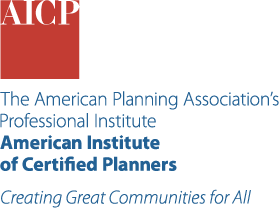Feb. 10, 2025
How we speak with our community members, decision-makers, fellow planners — and even our neighbors — matters. To be more inclusive and treat people respectfully, planners can be thoughtful about the language they use.
"If we are really trying to walk this walk and talk this talk of being more inclusive and being more representative of the populations that we're working with, then we need to do a better job of making people feel like we're not criticizing them, and we're not judging them or their community," says Samantha Castro, AICP, LEED-ND, who chairs the Diversity, Equity, and Inclusion (DEI) Committee for the Kentucky Chapter of the American Planning Association. "So much of that has to do with language and how we talk about people and the places and communities they hold dear. That's why word choice is so important."
People don't necessarily use outdated or hurtful terms on purpose — it's just what they are used to, says Castro, senior associate and Lexington office lead at TSW | Tunnell, Spangler, Walsh & Associates. She even feels nervous at times when speaking to students at the University of Kentucky, where she teaches. To stay updated on the latest terminology, particularly around gender, sexual identity, and race, Castro uses resources like the American Psychological Association's guide on bias-free language and BuzzFeed's style guide.
Castro says she has encountered changing definitions or stigmas attached to certain words. A frequently heard example has to do with the conversation around affordable housing. For a long time, she says, it was used as a well-intentioned way to steer clear of racially charged terminology. "But now that has its own stigma, so it's this ever-evolving thing," Castro says. "Now, people are using attainable housing. That makes more sense, because you're not just talking about a specific area median income. You're talking about that house."
"Any time you talk to somebody, a group, or especially when you're writing, you've got to take your whole audience to heart."— Caleb Knutson, planner and cochair of APA Iowa's DEI Committee
But affordable housing also has a technical definition — "housing on which the occupant is paying no more than 30 percent of gross income for housing costs, including utilities," according to the U.S. Department of Housing and Urban Development. So, while attainable housing is not always a perfect word swap in formal settings, using a phrase other than affordable housing may be a way to navigate through NIMBY barriers.
The same principle can be applied to terms such as workforce housing. Community members typically support the concept of creating places for police, teachers, and health care workers to live in the community. Castro says framing conversations around economic benefits — instead of focusing just on societal good — can help.
At community meetings, when there may be a divide about affordable housing, Castro begins with a question. "I like to start off by doing a quick show of hands with the audience of how many of them have ever had to rent at any point of their lives, be it college or whenever," she says. "I also like to bring up the fact that if you think about it, almost everyone that is in college or fresh out of college could apply for affordable housing. So, at a certain point in most people's lives, this housing could have served them. And everybody has a right to live somewhere."

Learn different ways to communicate tough concepts using alternative terminology in this APA webinar available to Passport subscribers.
Bringing people into the conversation, though, sometimes requires the right combination of the right words. Caleb Knutson, a planner and cochair of the DEI Committee for the Iowa Chapter of the American Planning Association, believes that it starts by factoring in the entire community. "Any time you talk to somebody, a group, or especially when you're writing, you've got to take your whole audience to heart," he says. "How you do that is important. Use words that are inclusive, because as planners and economic developers, so often historically, we have hurt marginalized communities."
Knutson believes planners have an ethical responsibility to create cities and communities where everyone can thrive. "But if someone reads a pamphlet or comes to a [public meeting] and hears language or terms that are outdated or don't make them feel welcomed, they are going to look somewhere else," he says. "They're going to think this community doesn't want them here."
4 Ways to Be More Inclusive
There is no magic elixir to accomplish these goals, but both Knutson and Castro have ideas on how planners can be more inclusive.
1. Crowdsource and listen
Find out if your state APA chapter or community organizations have resources available. When in public settings, Castro recommends starting with questions, like asking people how they want to be referred to. "One of the first things I do is to really take cues from the community," she says.
But for as many questions as you ask, also be ready to listen. "When you go into these spaces, make sure that you're not taking up air," Knutson stresses. "Make sure you are going there to learn."
2. Create a style guide for your team
Know what terms you are going to use, as well as which ones you will absolutely avoid. Castro says the American Psychological Association's section on bias-free language is a solid starting point.
3. Start using people-first language daily
Get rid of outdated terms and start living what you're learning. Ditch "homeless" and "poor" in favor of "people experiencing homelessness" and "people experiencing poverty."
4. Know you're going to make mistakes — and that's OK
"There's no way to get it [completely] right and say all the right things all the time, so you just have to give yourself grace and know that you are trying," Castro says. "I think the biggest part is you are attempting to talk to people in a way that is more compassionate."
And never stop wanting to learn. "I think it's just a mindset," Knutson says.
This article is part of a collaborative effort with APA's Upskilling Initiative and developed in part based on information included in an APA webinar available to Passport subscribers. The Upskilling Initiative empowers professionals with the tools they need to navigate the evolving landscape of planning.




